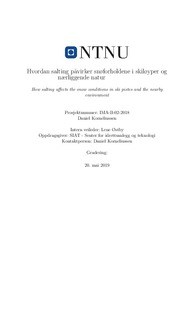Hvordan salting påvirker snøforholdene i skiløyper og nærliggende natur
Bachelor thesis
Permanent lenke
http://hdl.handle.net/11250/2610713Utgivelsesdato
2019Metadata
Vis full innførselSamlinger
Sammendrag
I løpet av dette prosjektet har det blitt diskutert ulike metoder for salting av snø i håp om å finne en optimal løsning for salting av snø i skiløyper. En forklaring på hvordan snø dannes, i tillegg til utvalgte fysiske egenskaper til snø, gir et grunnlag for resten av rapporten. Forskjellige metoder for salting har blitt sammenlignet både mot hverandre og en referansetest uten salting, metodene gikk ut på ulike kombinasjoner av salting, mekanisk behandling av snøen og vanning, alt utført ved Kyvannet, Trondheim. Grunnet flere usikkerheter ved forsøket er det vanskelig å si hvilken metode som fungerer best, men ut fra resultatene virker mekanisk behandling av snøen etter salting som den mest effektive metoden. Videre testing bør utføres for å bekrefte denne antagelsen.
Det har også blitt gjennomført tester for å sammenligne ulike mengder av fire salter: havsalt (natriumklorid), ammoniumnitrat, urea og kalsiumklorid. De har blitt sammenlignet på grunnlag av pris, fryseeffekt og miljøpåvirkninger. Havsalt kom best ut, men det tar litt tid før maksimal effekt oppnås så en blanding mellom havsalt og urea kan være en bra løsning. Med tanke på mengde salt som burde benyttes ble det konkludert med at 10-20 g salt per m2 løype bør gi bra nok effekt. Over the course of this project, different methods of salting snow have been discussed in the hope of finding an optimal solution for the salting of snow in ski pistes. An explanation of how snow is formed, in addition to certain physical properties of snow, form the basis for the rest of the report. Different methods were compared against each other as well as a reference test without salting, the methods were based on different combinations of salting, mechanical preparation of the snow and watering of the snow. Because of several sources of error and uncertainties it is difficult to say which method works the best, but based on the results it appears that mechanical preparation of the snow after salting is the most effective method. More tests should be carried out to confirm this assumption.
There were also carried out tests to compare different quantities of four salts: sea salt (sodium chloride), ammonium nitrate, urea and calcium chloride. They have been compared based on price, freezing effect and environmental effects. Sea salt came out the winner, however it takes a while before maximum effect is achieved, therefore a mixture og sea salt and urea could be a good solution. In regards to how much salt should be used, it was concluded that 10-20 g of salt per m2 piste should result in acceptable conditions for skiing.
